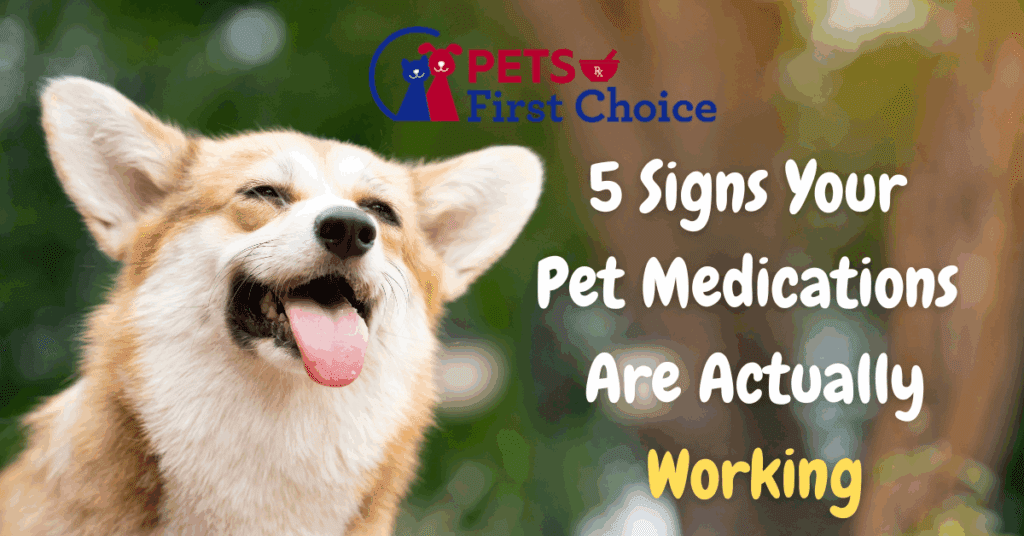5 Signs Your Pet Medications Are Actually Working

When your pet is sick or dealing with a chronic condition, starting a new pet medication can bring both hope and questions. As a pet parent, you want to know if the treatment is truly helping. While some improvements are obvious, others can be subtle — especially in pets who can’t tell us how they’re feeling.
Whether it’s dog medicine for joint pain, cat medicine for thyroid issues, or another type of animal medicine, understanding the signs of progress is key to supporting your pet’s healing journey. Here are five clear indicators that your pet’s treatment is on the right track.
1. Improved Mobility and Energy
One of the most common and noticeable signs of effective pet treatment is improved movement.
For dogs, this could mean they’re able to jump onto the couch again, climb stairs without hesitation, or go on longer walks without tiring. In dog health care, better mobility is often seen after starting arthritis medications, pain relief treatments, or post-surgery therapies.
For cats, you might notice more playfulness, easier grooming, or jumping to higher spots they previously avoided. Cat health improvements often show up in subtle ways — a once-slow cat suddenly dashing across the room or exploring more.
Improved mobility means less pain, better comfort, and a higher quality of life — strong signs your pet medication is working.
2. Better Appetite and Eating Habits
Loss of appetite is a common symptom in pets dealing with illness, injury, or chronic conditions. When your dog medicine or cat medicine starts to take effect, you’ll often see a renewed interest in food.
- For dogs: Watch for more enthusiasm at mealtime and fewer skipped meals.
- For cats: Look for consistent eating, reduced vomiting, and even weight gain if underweight.
This is not just a sign of pet recovery — it’s an important indicator of overall pet wellness. A healthy appetite usually signals improved comfort and reduced stress on your pet’s body.
3. Positive Behavior and Mood Changes
Pain, discomfort, and illness often cause pets to become withdrawn, irritable, or unusually quiet. Once animal medicine begins to work, their mood can shift dramatically.
Signs of improved pet health may include:
- More tail wagging or purring
- Increased playfulness
- Seeking affection more often
- Reduced restlessness or pacing
In dog health, you might notice your pet greeting you at the door again or showing excitement for walks. In cat health, this could mean more purring, rubbing against your legs, or sleeping in relaxed positions.
A happier pet is a sign of not just physical improvement, but emotional healing too.
4. Visible Physical Improvements
Some medications target visible symptoms, so physical changes can be a clear indicator of effectiveness.
Examples include:
- Shinier coat and healthier skin after allergy treatments
- Reduced swelling or redness after starting anti-inflammatory pet medication
- Cleaner eyes and nose for pets recovering from infections
In pet recovery, these changes often come alongside other signs of better health, reinforcing that the pet treatment plan is working.
5. Return to Normal Routines
Perhaps one of the strongest signs that dog medicine or cat medicine is helping is when your pet returns to their normal habits.
This might mean:
- Sleeping in their favorite spot again
- Playing with toys they previously ignored
- Grooming themselves regularly
- Showing interest in walks, treats, and cuddles
Routine behaviors signal stability in pet health and pet wellness. It’s a sign your furry friend is not just surviving — they’re thriving.
When to Contact Your Vet
While these five signs are encouraging, it’s important to remember that not every pet will respond the same way or on the same timeline. If you notice no improvement — or if your pet’s condition worsens — contact your veterinarian immediately. They may need to adjust the dosage, change the type of animal medicine, or explore alternative pet treatments.
Keep in mind:
- Some medications take weeks to show results.
- Side effects can sometimes mimic illness symptoms.
- Regular check-ups ensure your pet medication plan stays on track.
Supporting Your Pet’s Recovery
Alongside proper medication, you can help your pet heal faster by focusing on overall pet wellness:
- Provide a balanced diet tailored to dog health or cat health needs.
- Offer gentle exercise suited to their condition.
- Create a stress-free environment with plenty of rest.
- Use supplements only with veterinary guidance.
Your role in pet recovery goes beyond giving the right dose — it’s about creating an environment where healing can happen.
Final Thoughts
As a loving pet owner, your goal is to give your furry friend the best quality of life possible. By learning to recognize the signs that your pet medications are working — from better mobility to happier moods — you can feel confident that their pet treatment plan is making a real difference.
With patience, regular veterinary care, and a watchful eye on their progress, you can help your pet move from illness toward health, comfort, and joy.
👉 Visit Pets First Choice at https://petsfirstchoicerx.com/
to shop reliable products trusted by pet parents nationwide. Because your puppy deserves the best start. 🐶💛
